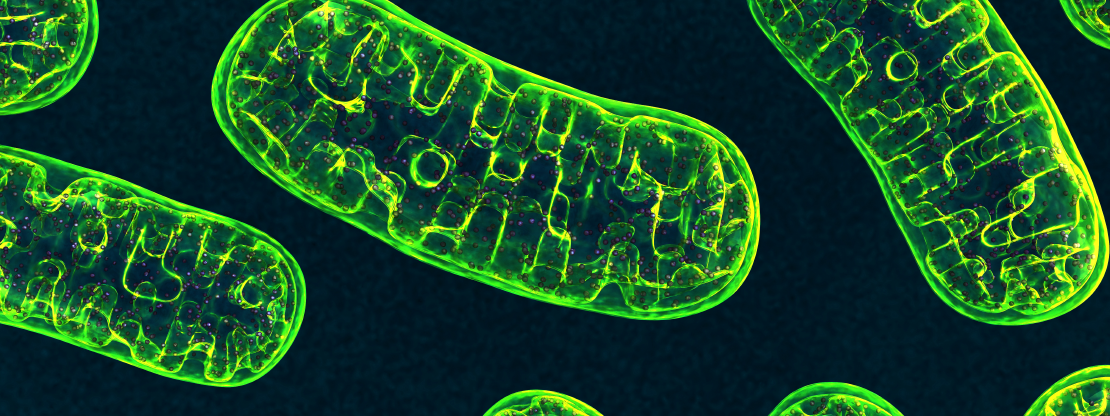What are Mitochondria & How do they work?


Mitochondria can be regarded as the energy factories of the human body. They are organelles (subcellular structures that perform specific tasks within the cell). Often found in large numbers in most cells, they are responsible for the biochemical processes of respiration and energy production at a cellular level. Mitochondria produce most of a cell’s supply of adenosine triphosphate (ATP), a molecule that cells use as a source of energy. Their main function is to provide energy for the cell by oxidising glucose. They also store calcium (for cell signaling activities), generate heat, and mediate cell growth and death.
The outer mitochondrial membrane is freely permeable to small molecules and hosts special channels capable of transporting large molecules. In contrast, the inner membrane is far less permeable, allowing only the smallest molecules to cross into their gel-like matrix that makes up the organelle’s central mass. This matrix is the container that hosts the deoxyribonucleic acid (DNA) of the mitochondrial genome and the enzymes of the tricarboxylic acid (TCA) cycle (also known as the citric acid cycle), which is responsible for the metabolism of nutrients into by-products a mitochondrion can use for energy production. The processes that convert these by-products into energy occur primarily on the inner membrane, which is bent into folds known as cristae that house the protein components of the main energy-generating system of cells, known as the electron transport chain (ETC). The ETC uses a series of oxidation-reduction reactions to move electrons from one protein component to the next, ultimately producing free energy that is harnessed to drive the phosphorylation of ADP (adenosine diphosphate) to ATP. This process, known as chemiosmotic coupling of oxidative phosphorylation, powers nearly all cellular activities, including those that generate muscle movement, fuel brain functions and more.
Why is Mitochondrial Health so Important?
Mitochondrial health is so important because of the vital roles mitochondria play in energy production. As one ages the amount of mitochondria that are produced by the body naturally declines, causing a variety of health issues. A partial list of diseases that can be caused due to low mitochondrial levels are as follows:
- Premature aging
- Alzheimer’s disease
- Autism
- Cardiovascular disease
- Chronic fatigue syndrome
- Dementia
- Diabetes
- Huntington’s disease
- Migraine headache
- Parkinson’s disease
With such a long list of common diseases known to be either caused by or aggravated by mitochondrial dysfunction, it is difficult to overstate the importance of keeping mitochondria levels sufficient especially as we age. For information on natural treatments for a wide range of health conditions visit Regenerative Nutrition’s health conditions page here.
Why Mitochondria Levels Fall with Age? (1)
Age-related changes in mitochondria are often associated with a decline in mitochondrial function. With advanced age, mitochondrial DNA volume, integrity and functionality decrease due to accumulation of mutations & oxidative damage induced by reactive oxygen species (ROS). In aged subjects, mitochondria are often characterized by impaired function such as lowered oxidative capacity, reduced oxidative phosphorylation, decreased ATP production, significant increase in ROS generation, and diminished antioxidant defence. Mitochondrial biogenesis declines with age due to alterations in mitochondrial dynamics and inhibition of mitophagy (the selective degradation of mitochondria), an autophagy process that removes dysfunctional mitochondria. Age-dependent abnormalities in mitochondrial quality control further weaken and impair mitochondrial function. In aged tissues, enhanced mitochondria-mediated apoptosis contributes to an increase in the percentage of apoptotic cells. However, implementation of strategies such as caloric restriction and regular physical training may delay mitochondrial aging and attenuate the age-related phenotype in humans. It is clear that a role of mitochondria in aging is more complicated than suggested by the mitochondrial theory of aging. Multiple changes in mitochondrial function, structure, distribution, and dynamics contribute to aging or age-related features.
Connections between CBD, Cancer and Mitochondrial Health
There are a magnitude of heath benefits for CBD and as research has become more accessible and we are starting to get a better understanding of cannabinoids and the effects they have on ones body has grown, and will continue to grow for many years to come. Anticancer properties of non-psychoactive cannabinoid cannabidiol (CBD) have been demonstrated on tumors of different histogenesis. Different molecular targets for CBD were proposed, including cannabinoid receptors and even some plasma membrane ion channels. It has been demonstrated that cell lines derived from acute lymphoblastic leukemia of T lineage (T-ALL), but not resting healthy T cells, are highly sensitive to CBD treatment. The effects of CBD does not depend on cannabinoid receptors or plasma membrane channels as thought previously. Instead, CBD directly targets mitochondria and alters their capacity to handle Ca2+(Calcium Ions). At high concentrations, CBD causes mitochondrial Ca2+ overload, stable mitochondrial transition pore formation and cell death. Results suggest that CBD could be an attractive candidate to be included into chemotherapeutic protocols and caner treatments especially for T-ALL patents. (T-All is a type of acute leukaemia meaning that it is aggressive and progresses quickly)
Understanding the components of cannabinoids
Cannabinoids are a group of more than 60 structurally related terpenophenolic compounds. Most of them exert their effects through cannabinoid CB1 and CB2 receptors, which belong to the family of G protein-coupled receptors. Lymphocytes mainly express CB2, whereas CB1 are highly expressed in the central nervous system (CNS). Cannabinoids have been used for decades in the field of palliative care. Recently two phytocannabinoids, Tetrahydrocannabinol (THC) and cannabidiol (CBD), were found to possess antitumorigenic properties. Contrary to THC, a well-known strong CB1 agonist with psychotropic effect, CBD has a low binding affinity for CB1/2 receptors and is considered as a “non-intoxicating drug”.
How CBD & Mitochondria interact plus how it can be effectively used in cancer patients. (2) (3).
Mitochondrial membrane potential dissipation is a hallmark of the mitochondrial permeability transition, known as (MPT) which is a cause for cell necrosis as well as intrinsic apoptosis (In the intrinsic pathway the cell kills itself because it senses cell stress, while in the extrinsic pathway the cell kills itself because of signals from other cells). Mitochondrial permeability transition pore (MPTP) is a transmembrane protein residing in the mitochondrial inner membrane. Normally closed, this large protein pore opens when stimulated by mitochondrial matrix Ca2+ accumulation (Calcium Ions), adenine nucleotide depletion, increased phosphate concentration or oxidative stress. There are a lot of free radical ions produced and mitochondria are subjected to many stress factors. Due to CBD’s ability to influence a cells Ca2+ handling capabilities, It can promote cell death, especially in damaged or stressed cells. CBD directly targets mitochondria and changes their capacity to handle Ca2+, which in turn affects multiple cellular functions, including ROS production and Ca2+ signaling, metabolic switch and the induction of autophagy and cell death. Considering the pivotal role of mitochondria in oncogenic re-programming (causing development or destruction of a tumor or tumors), CBD may be a plausible candidate to be included into chemotherapeutic protocols as well as helping to reduce tumour size. Healthy activated T cells were CBD-sensitive, but this population is small in patients with a weakened immunologic system. We have used T-ALL as an example but these benefits carry across a number of cancers. In conclusion it should be noted that the effects of CBD in cancer patients can be improved by increasing APT production and giving ones body the resources needed to kill and replace cancerous cells without exhausting the body’s APT reserves. Additionally by increasing APT levels; one will achieve optimal cellular energy levels allowing the body to deal with the energy draining damaged cells without fear of not being able to replace the cell with a fully functional healthy cell. Additionally, CBD has been shown to be importantly involved in the function of mitochondria. Since there is a lot of metabolism (production of ATP from food sources) happening in the mitochondria, there are also a lot of free radicals produced and mitochondria are subjected to many stress factors. CBD has been shown to function as a protective molecule for these organelles, it enable the mitochondria to maintain their function in spite of presence of free radicals or other mitochondrial disruptors. And we know CBD in itself functions as an antioxidant.
How CBD & Mitochondria interact plus how it can be effectively used in Epilepsy
The influence of CBD on mitochondria can also, in part explain why CBD is effective in many cases of seizures. In many forms of seizures there is a typical epileptiform calcium signal, which comes from the mitochondria. And if such cells are subjected to CBD, this epileptiform calcium signal is normalized, meaning that the trigger for the seizure is eliminated. And that has been firmly confirmed in epileptic seizures, where CBD has been shown to be particularly valuable in refractory epilepsies.
Taking into consideration the role of cannabinoids in the function of mitochondria, the effects of cannabinoids as very potent neuroprotective molecules is underlined. When exposing normally excited neurones to CBD, it has little effect on the cells (slight elevation of cytosolic calcium), but in contrast, when hyper excited neurones are subjected to CBD, the activity is reduced (a pronounced decrease in cytosolic calcium). This means when our nervous system is over active (stress, toxins etc), CBD can counterbalance this process, and secure the neurones, by protecting the function of the mitochondria in our nervous system. Meaning our neurones are protected, and remain their function.
Overview
Mitochondrial health is very important not only when treating illness, but also when naturally ageing. By naturally improving the bodies ability to produce Adenosine triphosphate, heathy mitochondria will thrive and damaged cells can repair/replace at a faster rate. CBD treatments for cancers and tumours may be more effective due to the body being able to destroy unhealthy cells and replace them with healthy cells, as well as protecting mitochondria and reducing stress from free radical ions and cellular waste. Additionally people going through chemotherapy may also gain benefits from improving their mitochondrial health, regardless of CBD use, by allowing the body to destroy more cells damaged by the radioactive nature of chemotherapy.
In neurological conditions such as epilepsy, the combination of improving ATP production while using CBD can help to protect the cells mitochondria, while also normalising Calcium ion (Ca2+) levels, in turn stopping seizures in their tracks. Over time as ATP rises, the cells will be better suited to handle stress and may be less likely to become overloaded with calcium in turn lowering the amount & intensity of seizures.
Increasing ATP (Adenosine triphosphate) production can help with a huge number of common sicknesses, as well as improving chronic conditions. ATP can be increased naturally by consuming fatty acids and proteins from lean meats like chicken and turkey, fatty fish like salmon and tuna, and nuts. A big problem is that to get enough fatty acids and proteins to promote healthy ATP production, it is common to over eat and in turn gain weight. On top of this it can be almost impossible for vegans to get enough ATP producing foods into a natural diet. To combat these issues we suggest supplementing with Zell Immunocomplex. Zell immunocomplex can justly be described as an essential supplement. A more balanced and fundamental approach than oxygen therapy, and in almost all cases a key part of a regenerative programme. Most of us are starved of oxygen, not because of low blood oxygen levels, but due to inadequacy of cell respiration; this in turn has been found to be due to poor mitochondrial structure and function. They have been aptly described as biological spark plugs. They act to trigger cellular activity, this includes respiration, and in turn, aiding cell nutrient uptake. When the mitochondria are functioning properly there will be activation of overall energy of the body, a strong active immune system and a good ability to heal/replace damaged cells and organs. This process is a corner stone of health. As we age the mitochondria get ‘lazy’. They can also be damaged by chemicals, pesticides, vaccinations and genetic defects. Because of this damage all kinds of illnesses have become prevalent such as fatigue, M.E., Cancer, mature Diabetes, MS, Parkinson’s, weakness of muscles, especially of the heart (including heart failure). Almost all of our bodily functions are hindered by damage and under-functioning to this vital part of our cells and rob our organs of energy, giving rise to an increasingly lowered immune system as well as increasing the chances of the development of all chronic disease. The rate of ageing is also increased by this damage. Due to a rapid turn over of our cells we may be able to cope with the occasional toxic dose of certain substances inhaled or ingested, however a continual onslaught as we experience now in our increasingly toxic world has a long term damaging effect on the mitochondria.
- Full Plain Jane Brand Review - January 15, 2022
- The Best Vape Deals in the UK - March 25, 2021
- CBD Gummies and How They Work - March 16, 2021


